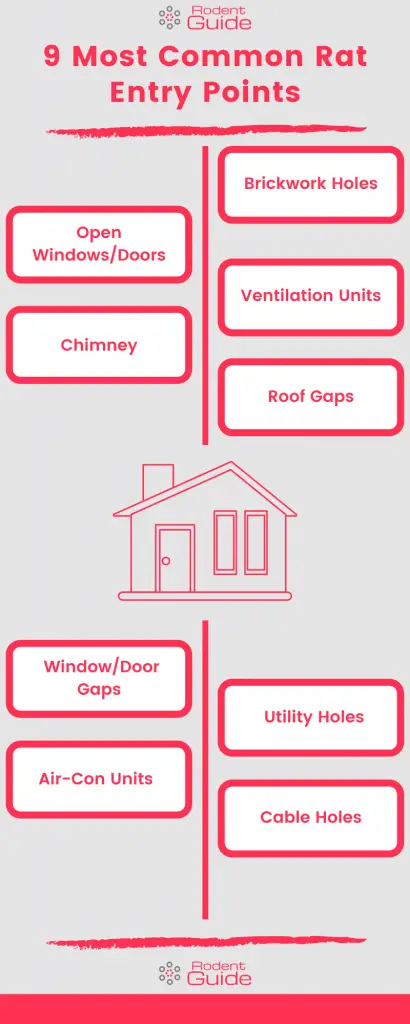Rats are one of the pests that I detest the most! They are persistent and clever (they can learn to avoid traps).
Not only that, but rats can be very dangerous! Simply put, I don’t want them in my house.
But how do I stop rats from getting into my house? Easy, I check around my home every month to identify and fix any rat entry points!
In this post, I will give you 9 of the most common entry points that rats will use to get access to your home so that you can prepare too!
Once you identify the entry points, you will need to remove them! More on that in this post too.

Rat Entry Points To Your Home
Before sealing up rat holes, you need to understand how to find rat entry points, and here are the top 9 that you can search for straight away!

Gap Between House And Roof
Rats are excellent climbers! They can climb up the brickwork, wood, and other objects. That means they can easily get onto your roof and into your home using any gaps between your house and roof.
Rats can also climb trees very, very easily! Any trees that overhang your property is a risk and will be used by rats to get onto your roof.
I’ve put this right at the top of the list. After all, it is often overlooked as a rat entry point because it is difficult to see, investigate, and fix any issues.
Brickwork Holes
Holes in your brickwork are another rat entry point.
These are easy to see, especially at the bottom of your home. For example, you may have holes in your brickwork left when cables and pipes have been removed.
It would be best if you sealed these holes in your brickwork straight away.
Utility Holes
Your home will have points where your utilities enter your home. I am talking about electricity, gas, or any other utility.
If you have gaps around the point where your utilities enter your home, these will be used as a rat entry point!
You should thoroughly check these entry points and seal them up where necessary.
Open Windows/Doors
When warm enough, folks like to leave windows and doors open. I know I do!
Leaving doors and windows open does allow rats to enter your home. A rat only takes a few seconds to get into your home. Instead, it will search for a place to hide and set up a rat’s nest if needed!
Air Conditioning
Gaps around the entrance to your air conditioning system are a common rat entry point.
You need to check thoroughly around where your air-con enters your home. As the entrance is likely to be large, there may be substantial holes that a rat can use to get into your home.
Gaps In Windows/Doors
Sometimes when windows and doors have been left unloved for some time, holes begin to develop around the perimeter of the window or door.
Any hole as big as a quarter will fit a small rat through. Most fully grown rats will need a hole of at least 2 inches to get through. It’s not that big! That gives you an idea of the gap you need to look for when checking your property for rat entry points.
Ventilation
I have a few ventilation points on my roof to let the moisture out of the attic. If these are damaged, they could let rats into your attic! Don’t forget that rats can easily chew through a bunch of materials. If it isn’t damaged when they get to the ventilation point, it might be damaged by the rat.
A few years back, I had a hole in my roof ventilation point. I knew this because I had a bird’s nest right at the bottom of the ventilation tubing!
Cable Holes
Cable holes, if not drilled correctly, can be a rat entry point. When drilling holes for cables, the gap around the outside (if there is one) needs to be filled.
It is also worth using cable bushing for both ends of the hole.
Chimney
Often overlooked, your chimney is a rat entry point that you can’t ignore.
Rats can easily climb up your roof and down your chimney! The brickwork in a chimney is usually rough and will allow the rat to grip as it descends.
How To Seal Off Rat Entry Points

Now that you have found a rat entry point, you must deal with it.
Depending on the type of entry point identifies, you may need to enlist the help of a professional, especially if it is around gas pipes or electricity cables.
Some of the tools I use are:
- Rat-proof wire mesh: Wire mesh (made from steel) is good enough to keep rats out. You should ensure that you have wire mesh at the bottom of each ventilation point. This is where I have added wire mesh, and it has never been breached.
- Caulk: Use this to fill gaps in brickwork or gypsum. Fill any holes inside and outside of your home. Although rats may be able to chew through this, it is doubtful that they will try because they will not know that it leads into your home!
- Steel Wool: Rats do not like chewing through steel wool! You can use this with the caulk above for additional security around a rat entry point. Never wedge steel wool into a gap, thinking that it will work. A rat will pull this out of the way and gain access.
- Rat Traps: I place traps outside my home to catch any that get too close. I also have several traps in my attic for those who breach any rat entry point I haven’t found.
Use some or all of these methods to seal your house from rats. It is the best form of rat control!
Frequently Asked Question

Is there ever just one rat?
Yes – there can be just one rat in your home. I have addressed rat issues before, where I have only caught one rat, and the problem has gone. You should be aware that rats can have many babies, so you must act if you think you have a rat in your home.
Where can I find rat entry points?
You should perform regular, thorough checks around your property to identify any rat entry points. Your checks need to include the lowest point of your home, right up to the highest point! Any gap bigger than 2 inches needs to be filled. Even if it is only outside your home, rats can also get into your cavity walls. From there, they can get to the rest of your home.
How do rats get into houses?
Rats can enter your home from any entry point larger than 2 inches. Smaller rats only need a gap as big as a quarter to gain access. A rat can use these holes anywhere on your property, including the roof. If you regularly get rats, you should be outside sealing up rat holes as you find them.
Conclusion
In this post, we have gone through 9 of the most common rat entry points and covered how to seal off rat entry points.
The most important thing is that you perform these checks regularly. Brickwork holes and other objects that can host a rat entry point can appear at any time. Houses may shift slightly, and weather conditions may create holes.
When you find a rat entry point, seal these off ASAP.
Good luck!








